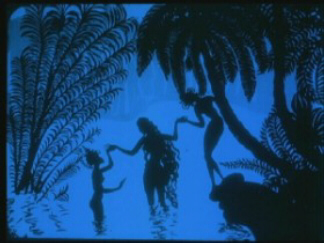CGI? What’s that?
The purpose of this blog has been twofold: I get to exercise my writing muscles on classic films everyone has seen. More rarely, I get the joy of turning my audience on to really good stuff of which they may not have heard. This week it’s the latter, kids, seriously tasty treats spilled from a glittering cinema cornucopia.
I refer of course to The Adventures of Prince Achmed, completed in 1926 and the earliest surviving full-length animated film, but in a larger sense to the entire body of work of its creator, Lotte Reiniger. Look at the illustration above. See those bathing nymphs? All that ferny subtropical vegetation? The cascading hair of the central figure? The delicately rendered water reflections? Every single one of them were cut out with scissors by one woman and photographed by her, on an intricate shadow camera system she invented.
Lotte Reiniger (1899-1981) was a genius, a cultural treasure, a magnificent artist who lived hand to mouth most of her life, as she and her husband dodged fascists and searched for project backers. Exposed at an early age to the fantastic films of Georges Méliès, at the age of 16 she developed a crush on actor Paul Wegener (Der Golem) and got her parents to enroll her in Max Reinhardt’s theater company, to which Wegener belonged. This sort of story rarely turns out well, but in Reiniger’s case everything went right. The young lady began making silhouette portraits of her fellow actors, of such high quality Wegener was impressed and commissioned her silhouette titles for his next film, an adaptation of the Pied Piper story.
So well were her contributions to the film received that she was admitted to an experimental animation studio, where she met her life partner Carl Koch, a writer and director. They found a patron in Louis Hagen, a wealthy banker who commissioned a film from them. The result is The Adventures of Prince Achmed.
It’s a joy to watch, from start to finish, especially when you bear in mind that every single thing you see was created by Reiniger with a pair of scissors or, in some few cases, brushed sand or light projections. The results are breathtaking, primal storytelling with shadows and light. Reiniger’s silhouettes even convey facial expressions. It’s hard to imagine anyone would be capable of this quality of work now.
Prince Achmed’s story is drawn from elements in The Book of One Thousand and One Nights. An evil wizard lusts after the beautiful daughter of the Caliph. To win her hand he creates a mechanical flying horse, and rides it to the Caliph’s palace. The princess’s brother insists on having a ride on the horse and it bears him aloft, into a host of adventures that include dalliance with handmaidens, battle with demons, a quest to rescue a peri queen, an encounter with Aladdin, a shapeshifting duel… and an ugly old witch who is a heroine, for a change.
Make your inner four-year-old comfortable when you sit down to watch this one, and enjoy going along for the ride. As I watched, all sorts of memories began to surface and I realized that I had seen this, as well as many of Reiniger’s later works, when I was four: she animated a number of classic fairytales for American TV in the 1950s. They enchanted me then, with their beauty and complexity, and I was delighted to discover that they have apparently survived and are available on DVD.
Is it suitable for watching with your real, external child? It is, unless you mind a faintly racy sequence in the peri queen’s palace. Or you’re hypersensitive to 1920s-style depictions of the inhabitants of Turkey or China, which in Reiniger’s case are no more stereotyped than Disney’s Aladdin or Mulan. I just dealt with it. It’s a fairytale, for crying out loud. If your offspring has reached the age where first-person-shooters and Dragonball Z are prime entertainment, you probably won’t be able to convince them they’ll enjoy The Adventures of Prince Achmed. If you have a little incipient geek, though, the sheer How-did-she-do-that quotient is enough to make your kid pick up scissors and paper and essay a silhouette or two of his/her own.
The DVD from Image Entertainment (or the BFI, if you’re in Europe) offers a nicely restored print, which is all the more remarkable in that the original negative and nitrate print have been lost; what you see on the screen has been pieced together from fragmentary copies. Included is a documentary on Reiniger and a charming little surprise: the most original commercial for Nivea Lotion you are ever likely to see.










